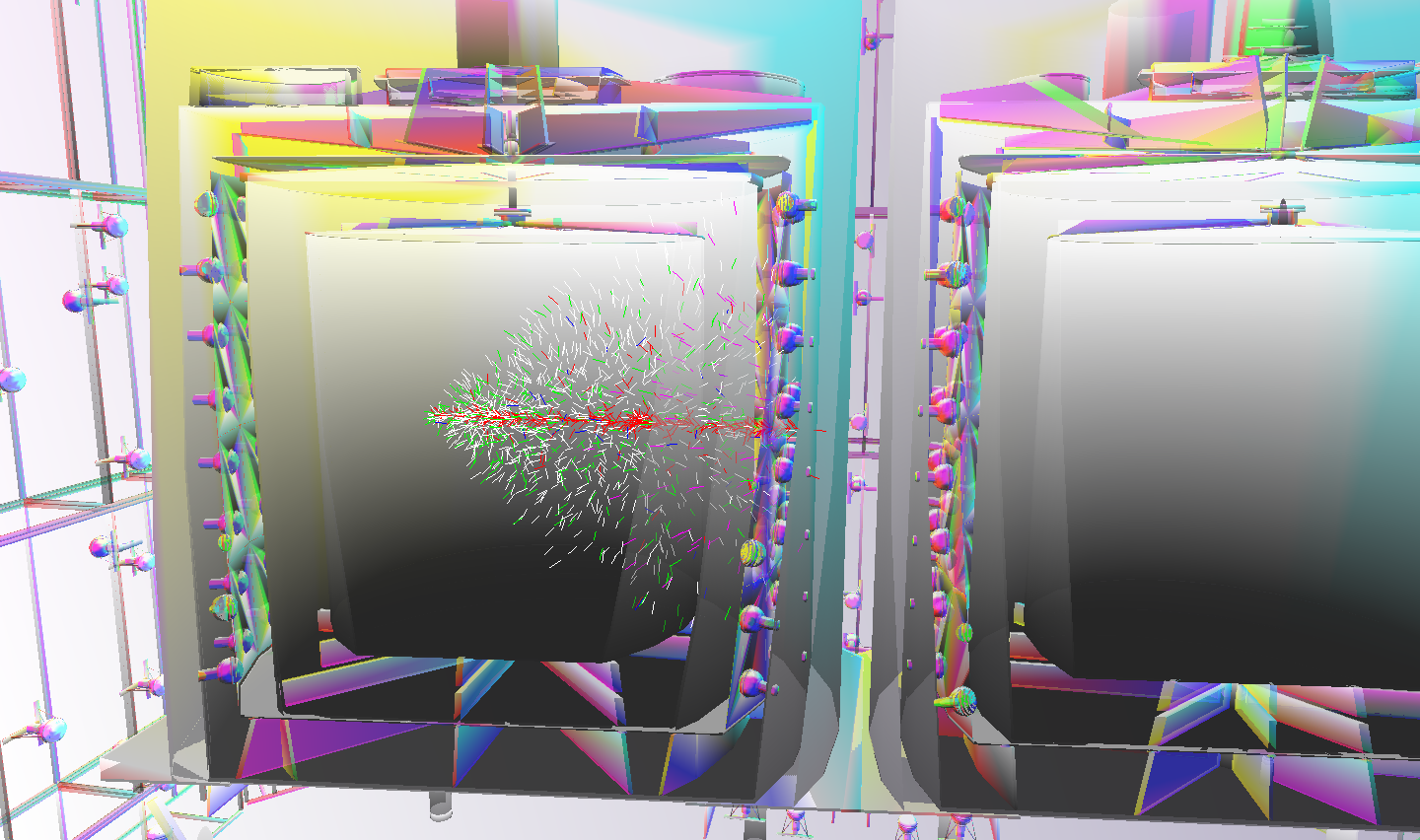GPU Accelerated Geant4 Simulation with G4DAE and Chroma
http://simoncblyth.bitbucket.io/env/presentation/gpu_accelerated_geant4_simulation.html http://simoncblyth.bitbucket.io/env/presentation/g4dae_geometry_exporter.html http://simoncblyth.bitbucket.io/env/presentation/gpu_optical_photon_simulation.html
Drastic 200x Potential Speedup
Chroma project claims 200x speedup of optical photon (OP) propagation compared to Geant4. A goal worthwhile chasing.
- Geometry Model Implications
- Introducing Chroma
- Geant4 <-> Chroma Integration
- G4DAE Geometry Exporter
- Validating GPU Geometry
- G4DAEChroma bridge
- Chroma Forked
- Validating Chroma Generated Photons
- Next Steps
- Visualizations
Implications of Geometry Model Choice
Track > Geometry intersection typically limits simulation performance. Geometry model determines techniques (and hardware) available to accelerate intersection.
Geant4 Geometry Model (solid based, locked in)
Tree of nested solids composed of materials, each shape represented by different C++ class
Chroma Geometry Model (surface based, extremely simple > portable)
List of oriented triangles, each representing boundary between inside and outside materials.
3D industry focusses on surface models >> frameworks and GPU hardware designed to work with surface based geometries.
Chroma : Ultra-fast Photon MC, Developed by Stan Seibert, University of Pennsylvania
Chroma tracks photons through a triangle-mesh detector geometry, simulating processes like diffuse and specular reflections, refraction, Rayleigh scattering and absorption. Using triangle meshes eliminate geometry code as just one code path.
Original Motivation for G4DAE exporter
Allow use of Chroma GPU accelerated optical photon propagation with existing DayaBay Geant4 geometry.
200x performance claim:
With a CUDA GPU Chroma has propagated 2.5M photons per second in a detector with 29k photomultiplier tubes. This is 200x faster than GEANT4.
BUT Chroma needs : triangles + inside/outside materials
http://on-demand.gputechconf.com/gtc/2013/presentations/S3304-Particle-Physics-With-PyCUDA.pdf
https://bitbucket.org/chroma/chroma
https://bitbucket.org/simoncblyth/chroma (my fork)
Standard Geant4 Workflow
Some invisible vertical space
.
.
.
OP Generated in Cerenkov and Scintillation G4VProcess, some reach PMTs and form hits.
.
.
.
.
.
// G4VProcess subclass PostStepDoIt(const G4Track&, const G4Step&) { // calculate NumPhotons aParticleChange.SetNumberOfSecondaries(NumPhotons); // generate and collect secondaries for (G4int i = 0; i < NumPhotons; i++) { ... aParticleChange.AddSecondary(aSecondaryTrack); } } // G4VSensitiveDetector subclass bool ProcessHits(G4Step* step, ...) { // form hits from step information }
Geant4 <-> Chroma Integration
Bridging to external OP simulation
Optical photons (modulo reemission) are the leaves of the simulation tree, allowing external simulation to be integrated rather simply.
Recreate Geometry info on GPU (G4DAE)
- export triangulated geometry as COLLADA/DAE files
- export PMT identifiers associating sensors with volumes
- import geometry and identity files into Chroma and upload to GPU
Runtime bridge via message queue (G4DAEChroma)
- collect generation step parameters and prevent photon processing by not forming secondaries
- send generation steps to Chroma and receive hits in reply
- include hits into standard Geant4 hit collections, subsequent simulation proceeds normally
GPU Optical Photon simulation (Chroma)
- receive generation steps from message queue
- copy generation steps to GPU and allocate GPU memory for photons
- invoke generation and propagation CUDA kernel
- copy propagated photons back to CPU
- send reply with hits back to G4DAEChroma
External Photon Simulation Workflow
https://bitbucket.org/simoncblyth/g4dae
Inclusion into Geant4
Geometry exporter presented at Sept 2014 Geant4 Collaboration Meeting. Proposal to contribute was accepted, intended to be included with 2015 Geant4 release.
Exports Geant4 Geometry into COLLADA/DAE standard 3D files, based on GDML writer code, same XercesC dependency for XML handling. Export includes:
- volume tree: solid/physical volume/logical volume heirarchy
- geometry: vertices, triangles+quads (triangulation from G4Polyhedron)
- materials and surfaces with properties as function of wavelength (using DAE extra XML elements)
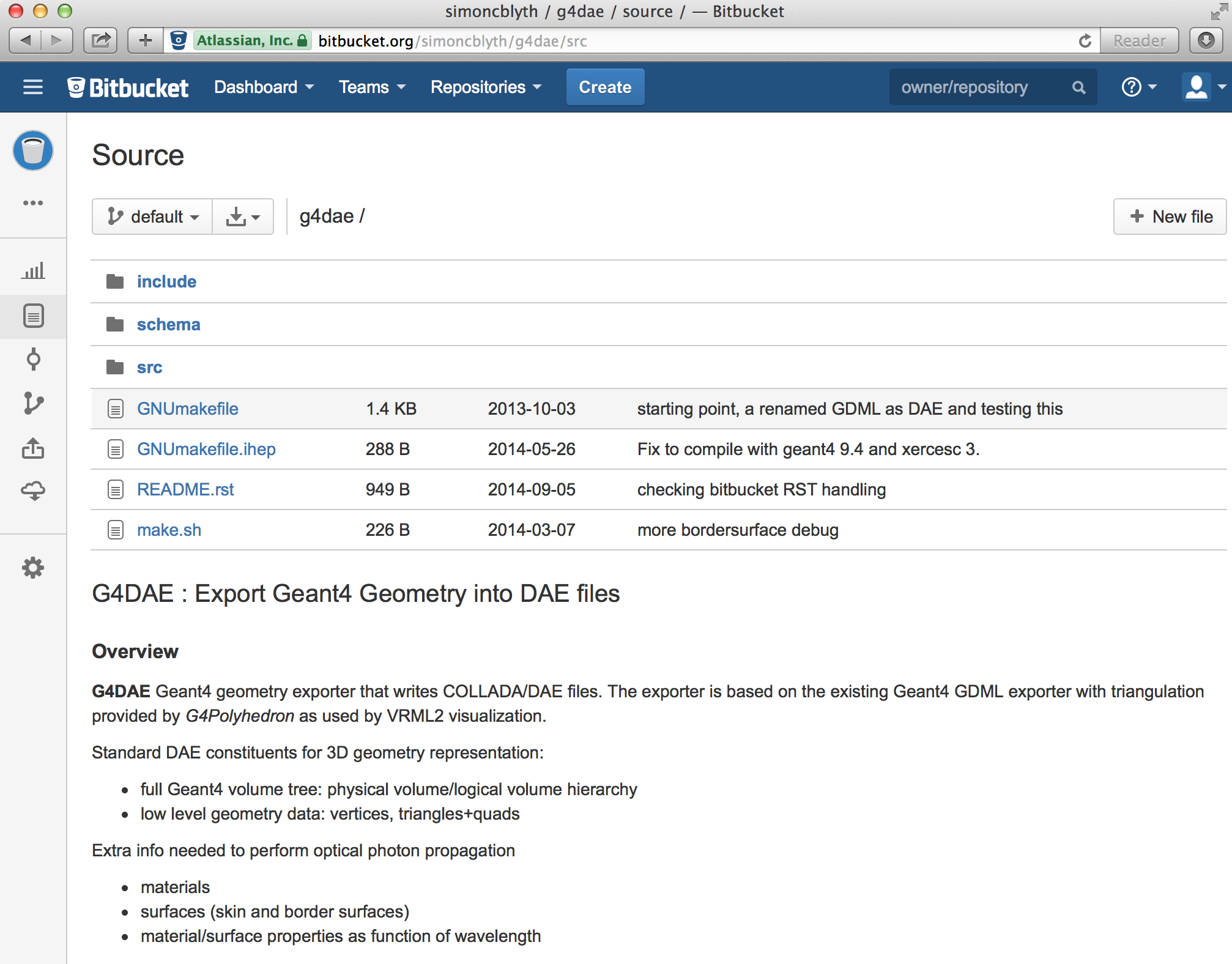
Liberated Geometry allows Ubiquitous High Peformance Visualization
Geometry Set Free
Liberating geometry data from Geant4/ROOT gives free choice of visualization packages. Many commercial, open source apps/libs provide high performance visualization of DAE files using GPU efficient OpenGL techniques. => Shockingly Smooth Visualization performance
Commercial:
- Finder/Quicklook/Preview/Xcode (standard OSX 10.8+)
- Xcode : useful effect tweaking interface
- Preview : set black background for visibility
- Sketchup 8 free (OSX) [also Windows]
- ESKO Studio Viewer free (iOS on iPad)
Open source:
- Meshlab (OSX/Linux), slow DAE loading, OK interface [also Windows]
- Blender (OSX), painful GUI [also Windows/Linux]
- g4daeview (OSX/Linux), extremely useful for debugging
Frameworks:
- pycollada, Python COLLADA parsing/construction, lxml + numpy powered fast parsing
- threejs, Javascript COLLADA loading, renders HTML canvas with WebGL
- SceneKit, Objective C Framework used by OSX apps
Many more applications and frameworks listed http://en.wikipedia.org/wiki/COLLADA
http://meshlab.sourceforge.net https://bitbucket.org/simoncblyth/meshlab (fork improves COLLADA loading speed)
g4daeview.py : Fast OpenGL 3D viewer for G4DAE files
PyOpenGL Based
Easy to extend due to fast python development, yet access to highly efficient OpenGL techniques such as VBOs, PBOs and GLSL shaders.
G4DAE visualization [1] implemented with PyCollada, PyOpenGL and Glumpy
- very fast/responsive 3D OpenGL visualization [2]
- flexible tree/list based partial geometry loading
- intuitive virtual trackball translate/rotate
- parallel or perspective projections
- interactive fov and near/far plane clipping
- persistent viewpoint bookmarks
- animation by interpolation between bookmarks or orbiting
- numerical control via UDP remote messaging
- live Geant4 connection, photon, genstep visualization, single stepping
- easily extensible python implementation [3]
- photon picking interface, with property inspection
Also used for testing GPU photon propagation with Chroma project
- interactive raycasting, including animated
- propagation visualization, with time slider
| [1] | http://simoncblyth.bitbucket.io/env/notes/geant4/geometry/collada/g4daeview/g4daeview_usage/ |
| [2] | Implemented with single OpenGL Vertex Buffer Object (VBO) for entire geometry |
| [3] | https://bitbucket.org/simoncblyth/env/src/tip/geant4/geometry/collada/g4daeview/ |
Compare DAE Exports to GDML and VRML2(WRL)
Export validation:
- Comparison of all vertices/faces reveals boolean solids are discrepant.
- Perfect [4] DAE WRL agreement achieved by cheating : perform triangulation once and reuse.
- Boolean solid triangulation sensitivity must be kept in mind as a potential systematic for computational uses
- DAE not much bigger than GDML, despite including all triangles/vertices [5]
| Qty | DayaBay | Lingao | Far | Juno x0.5 |
|---|---|---|---|---|
| Volumes | 12,229 | 12,229 | 18,903 | 25,000 |
| Triangles | 2,448,064 | 2,448,064 | 4,189,680 | 21,886,158 |
| Vertices | 1,245,996 | 1,245,996 | 2,128,208 | 10,993,079 |
| DAE/GDML/WRL (MB) | 6.9/4.0/98 | 6.9/4.0/96 | 8.6/6.0/167 | 6.1/-/- |
VGDX_20140414 counts using g4daeview.py -g 0: --with-chroma, Juno geometry truncated
| [4] | Maximum DAE WRL offset < 0.13 mm, after patching VRML2 export precision bug (fixed in current G4). Details: http://simoncblyth.bitbucket.io/env/notes/geant4/geometry/collada/dae_cf_wrl/ |
| [5] | Geometry is not repeated, instead the COLLADA format uses geometry instancing and a tree of transforms, just like GDML |
Chroma Raycasting : exercises geometry intersection
Raycasting exercises slowest part of optical photon propagation: geometry intersection.
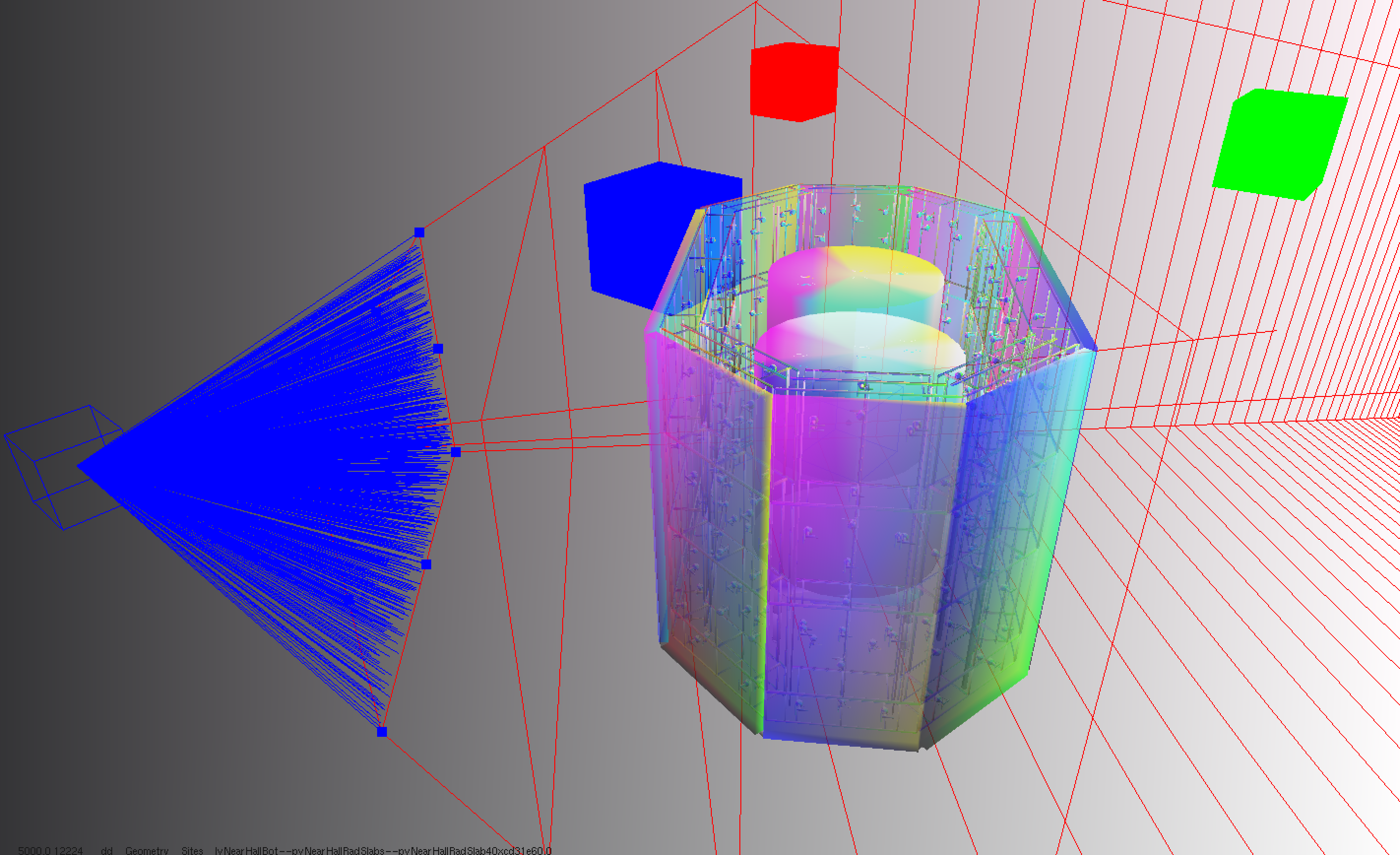
- Shoot rays thru every pixel out into geometry, 1 CUDA thread for each, typically >1M rays
- Find triangle intersections using BVH [6] acceleration structure
- Determine color based on ray to triangle normal angle
- Alpha blend nearest 10 surfaces, providing transparency effect
| [6] | Boundary Volume Heirarchy, a tree of bounding boxes with triangles inside leaf nodes |
Chroma Raycast with entire geometry in view
Render Split into 3x3 CUDA kernel launches, 1 thread per pixel, ~1.8s for 1.23M pixels, 2.4M tris (with [7])
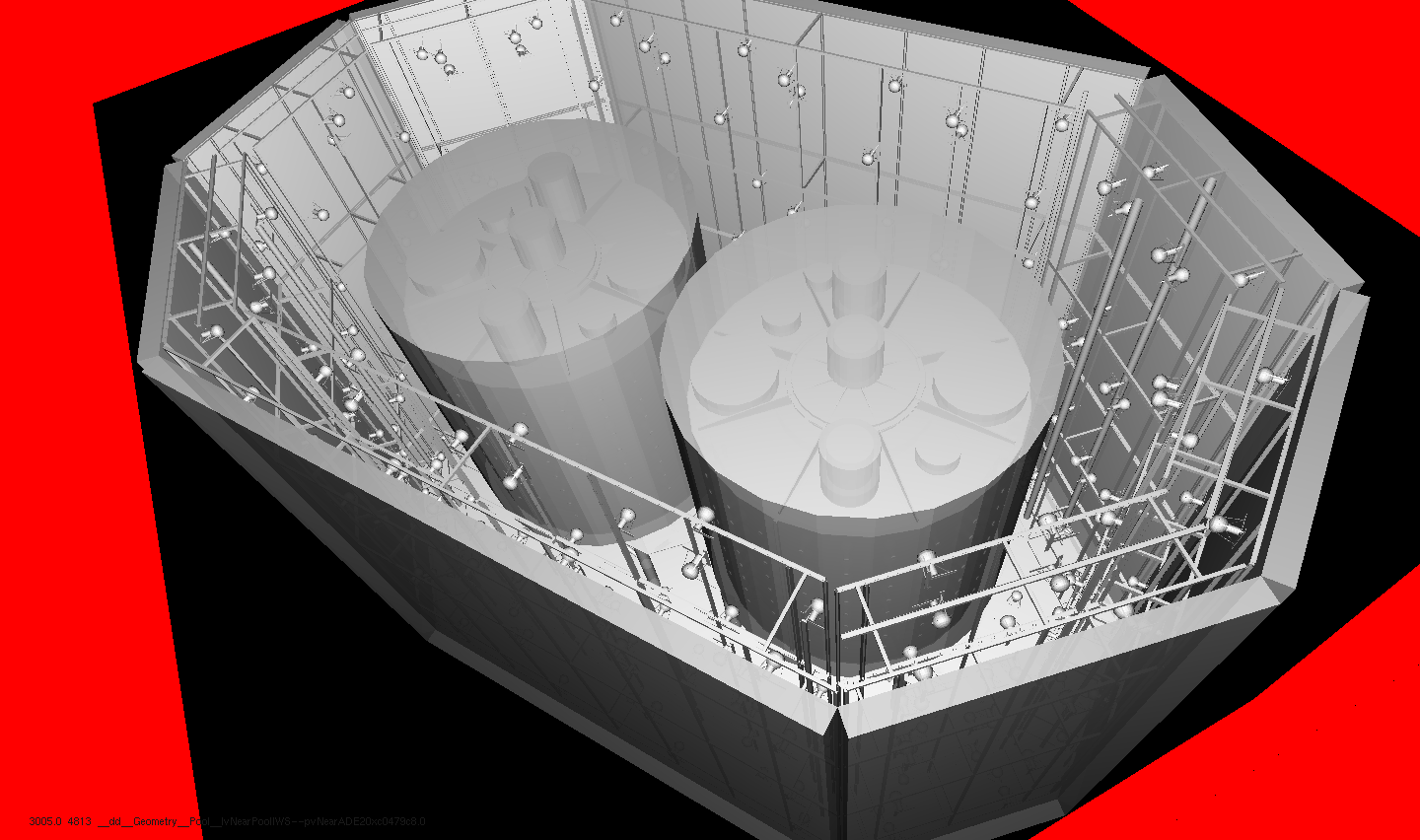
| [7] | MacBook Pro (2013), NVIDIA GeForce GT 750M 2048 MB ; Workstation GPUs such as NVIDIA Kepler K20 expected at least ~5x faster |
G4DAEChroma : Bridging from Geant4 to Chroma
https://bitbucket.org/simoncblyth/env/src/tip/chroma/G4DAEChroma/G4DAEChroma/
Transport Infrastructure
Collects generation steps from Geant4, sends to Chroma, receives hits in reply, integrates into G4 Hit Collections. Implemented with core of ~20 C++ classes
- Two detector specific subclasses required eg DybG4DAECollector DybG4DAEGeometry
- NumPy array creation from C++, transport via ZeroMQ
- JSON metadata communication C++/Python, map<string,string> <-> dict
- Geant4 hit integration using additional G4VSensitiveDetector that steals hit collection pointers from existing one
- Transform Cache to obtain PMT local coordinates from global hit coordinates
- SQLite DB integation for monitoring/control
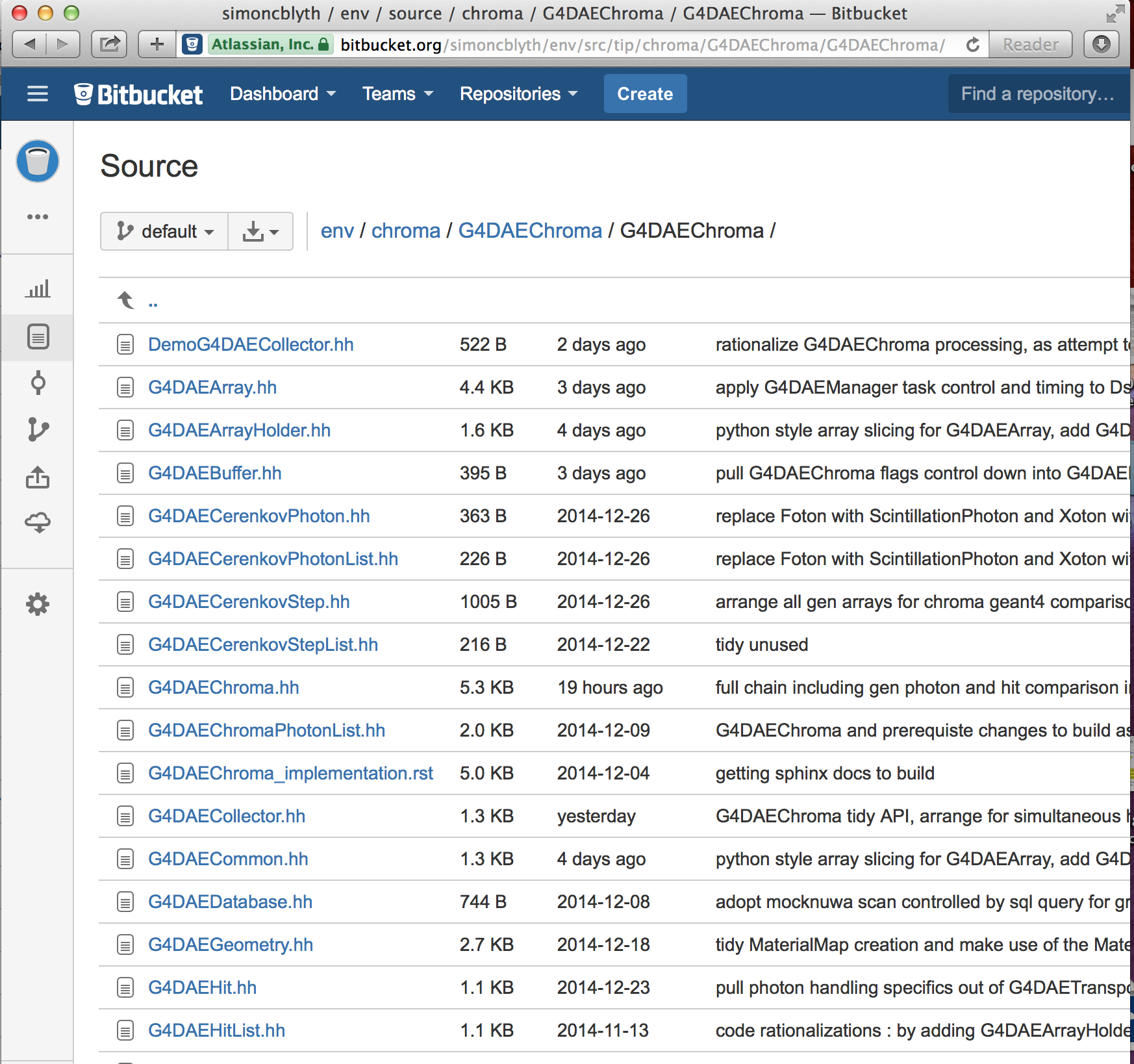
G4DAEChroma : For implementation details...
http://simoncblyth.bitbucket.io/env/notes/chroma/G4DAEChroma/G4DAEChroma/G4DAEChroma_implementation/
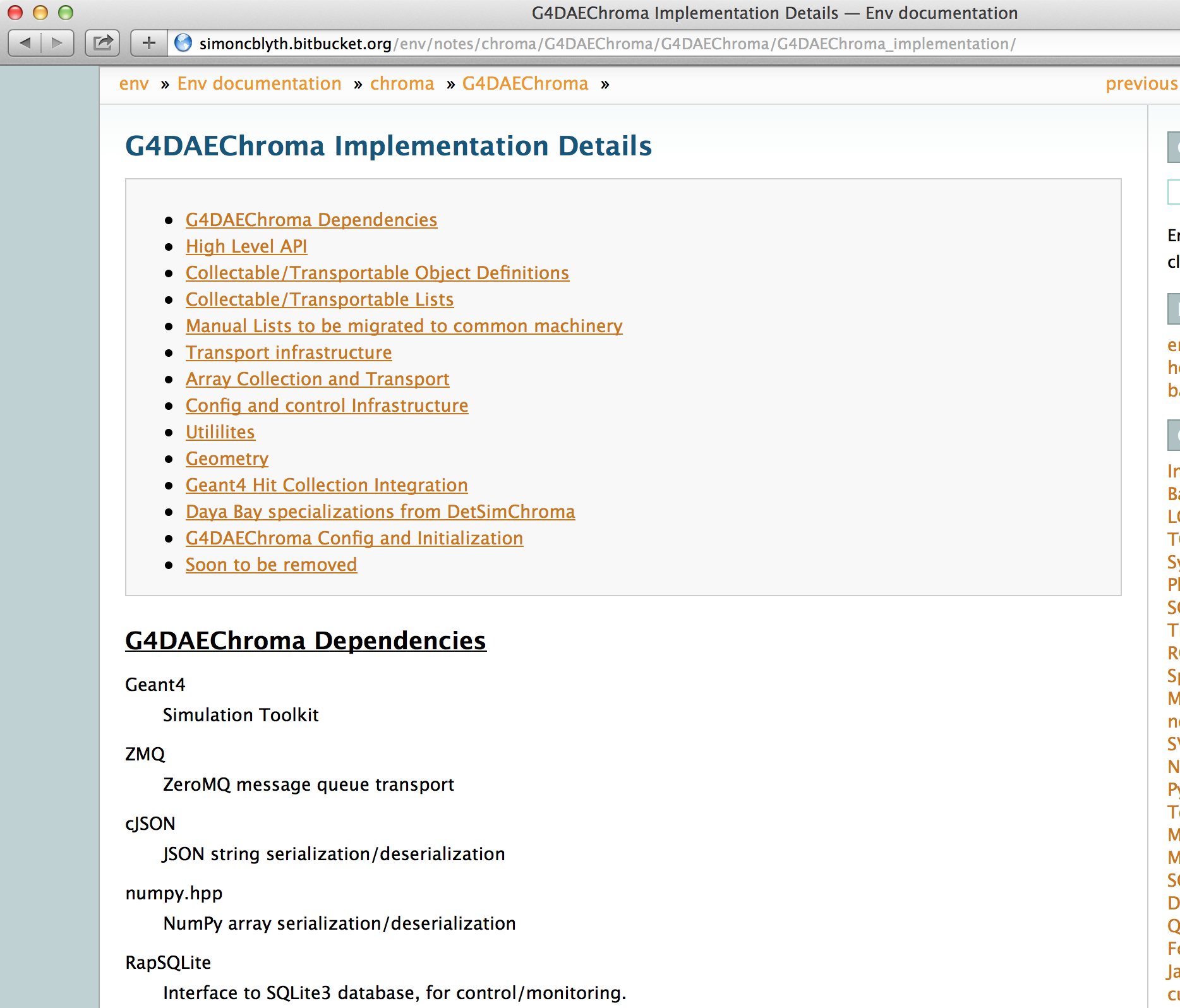
https://bitbucket.org/simoncblyth/chroma Forked:
Changes in my fork of Chroma:
- stability + efficiency improvements, enabling mobile development
- OpenGL/CUDA interoperation, using VBOs
- add recording of propagation steps into VBO datastructure
- more efficient Raycasting using 4x4 matrix uniforms and PBOs
- animated photon propagation visualization
- change serialization approach from ROOT/TObject to NumPy (NPY)
- generation of Cerenkov and Scintillation Photons based on Geant4 Generation Step inputs
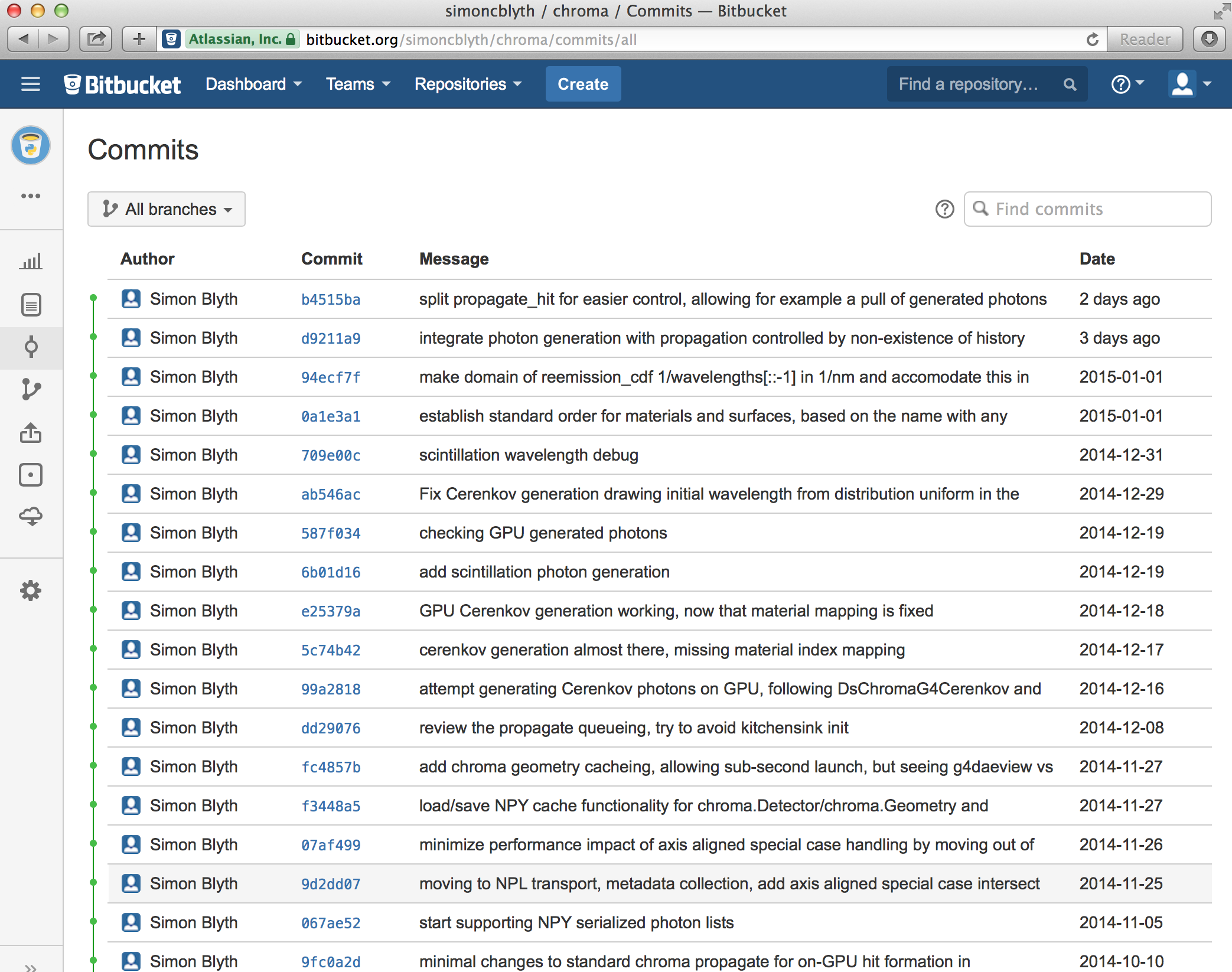
Chroma Generated Scintillation Photons cf Geant4
Chroma interpolates all properties in 20nm bins, stair artifacts in wavelength distribution can be reduced by using eg 10nm property interpolation bins.
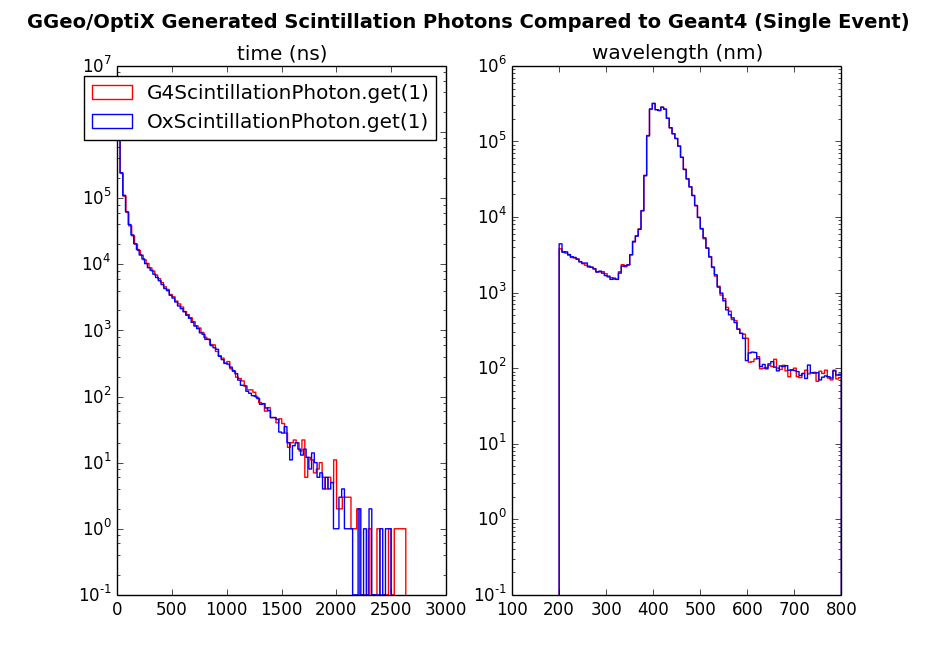
Chroma Generated Cerenkov Photons cf Geant4
Geant4/DetSim wavelength distribution has a blip at 200nm, corresponding to edge of water refractive index properties. (see the extra slides)
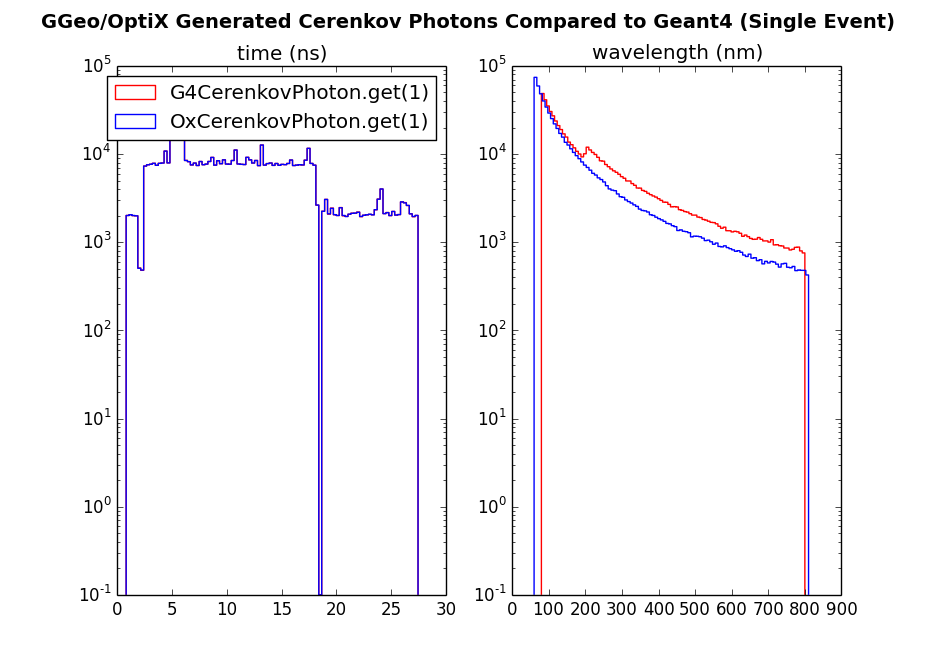
Next Steps
G4DAE Geometry Exporter
- implement parametrized/replica geometry handling, following GDML
- investigate issue inherited from GDML of a skipped edge case (when a volume is shared between multiple volume pairs) resulting in missing G4LogicalBorderSurface
- investigate improving default export appearance in common viewers
- test with newer and latest versions of Geant4
- test on more detector geometries
- incorporate into Geant4 codebase
G4DAEChroma bridge
- refactor to remove duplication in G4DAEHit G4DAEHitList
- eliminate use of cnpy external in favor of numpy.hpp
Chroma
- Port Cerenkov ApplyWaterQE to Chroma (expect quick)
- Port DsPmtSensDet::ProcessHits QE gymnastics to Chroma
- Implement double sided surfaces, to match G4LogicalBorderSurface
- Compare PMT Hit distributions between NuWa/DetSimChroma and NuWa/DetSim
- iterate until match achieved or discrepancies explained
- Find desktop GPU on which can test operation and performance
Cerenkov Photons Simulation - Side View
Cerenkov Photons
Simulated Cerenkov shock front from an 100 GeV muon travelling from right to left across Dayabay AD. Primaries are simulated by Geant4, Cerenkov "steps" of the primaries are transferred to the GPU where photons are generated, propagated and PMT hits formed. Photon colors indicate reemission (green), absorption(red), specular reflection (magenta), scattering(blue), no history (white).
Scintillation Photons Simulation - Side View
Scintillation Photons
Simulated Scintillation photons from an 100 GeV muon travelling from right to left across Dayabay AD. Primaries are simulated by Geant4, Scintillation "steps" of the primaries are transferred to the GPU where photons are generated, propagated and PMT hits formed. Photon colors indicate reemission (green), absorption(red), specular reflection (magenta), scattering(blue), no history (white).
Cerenkov Photons Simulation - Top View
Scintillation Photons Simulation - Top View
Extra Slides
g4daeview.py : OpenGL view of Juno Geometry
External view of Juno geometry with cutaway. The extreme size of the Juno geometry (50 million nodes in Chroma representation) provides a challenge for development on mobile GPUs. As my developments operate at the Geant4 level wherever possible it was relatively straightforward to apply the machinery developed for Dayabay to the Juno detector. In collaboration with Juno simulation experts the geometry was exported from Geant4 and GPU visualized in under a days work.
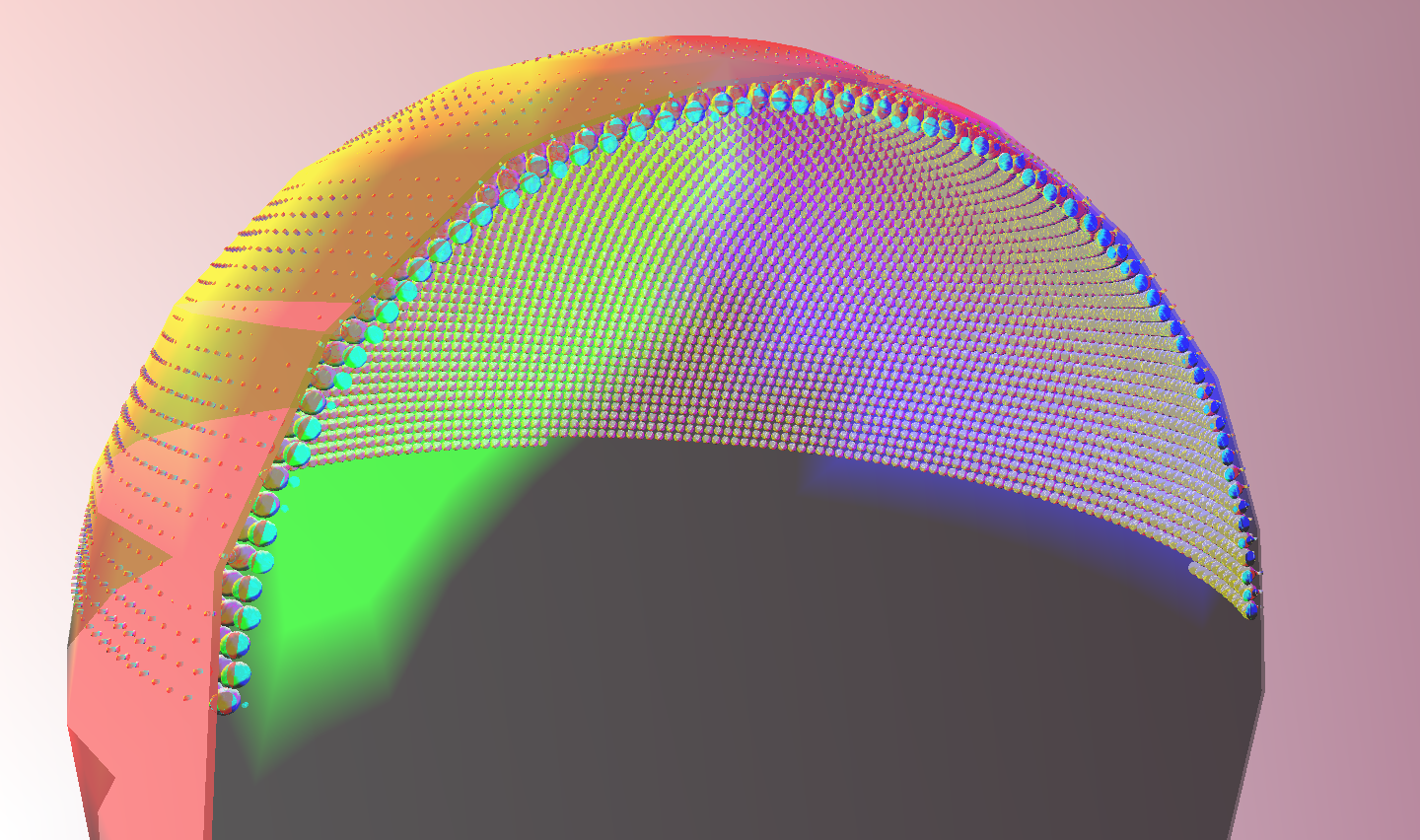
g4daeview.py : Chroma Raycast of Juno Geometry
External view of Juno geometry. The extreme size of the Juno geometry (50 million nodes in Chroma representation) provides a challenge for development on mobile GPUs. The black rectangle arises due to aborts to avoid GPU crashes.
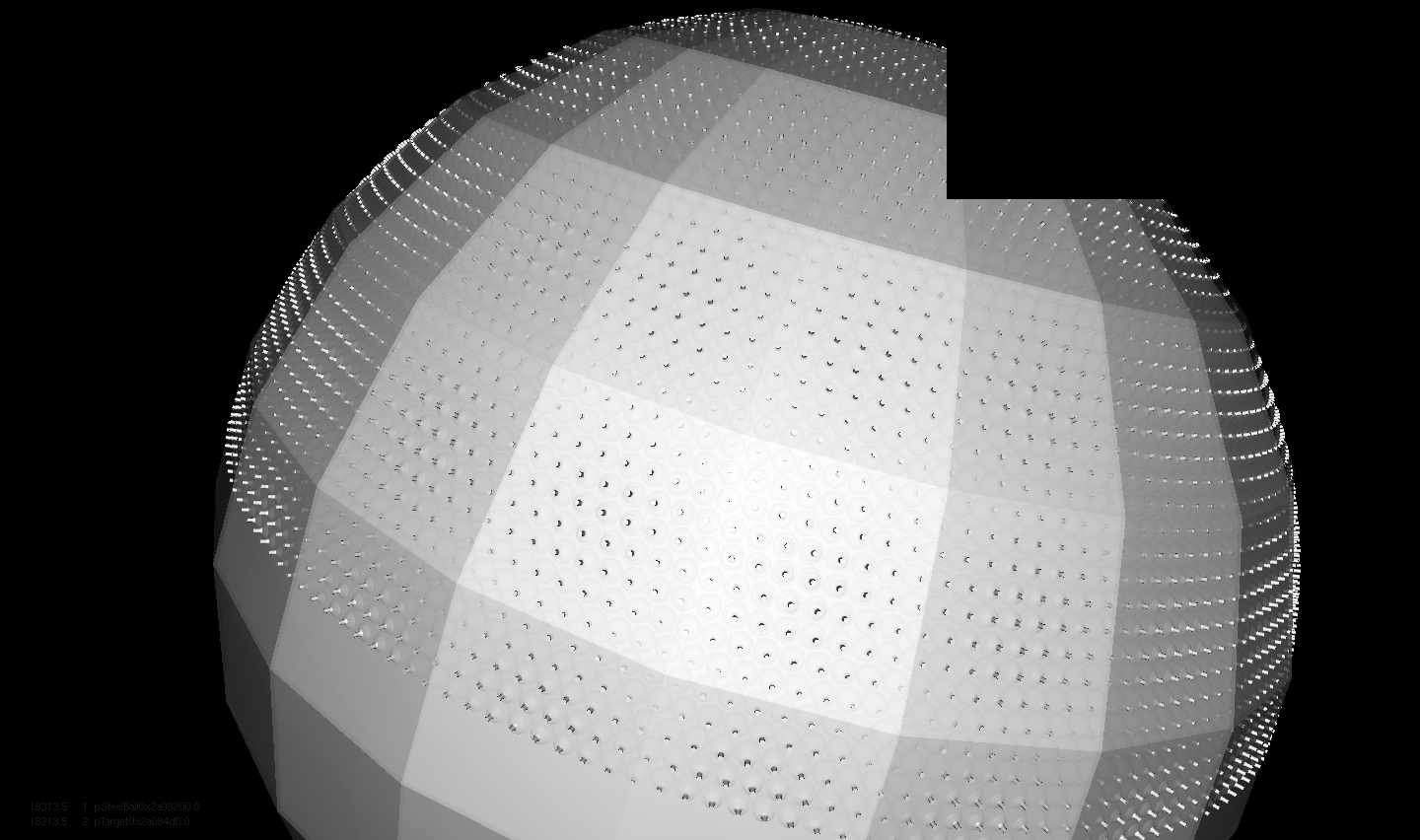
G4 Generated Cerenkov Wavelengths in material categories
Blip caused by 200nm edge in water refractive index
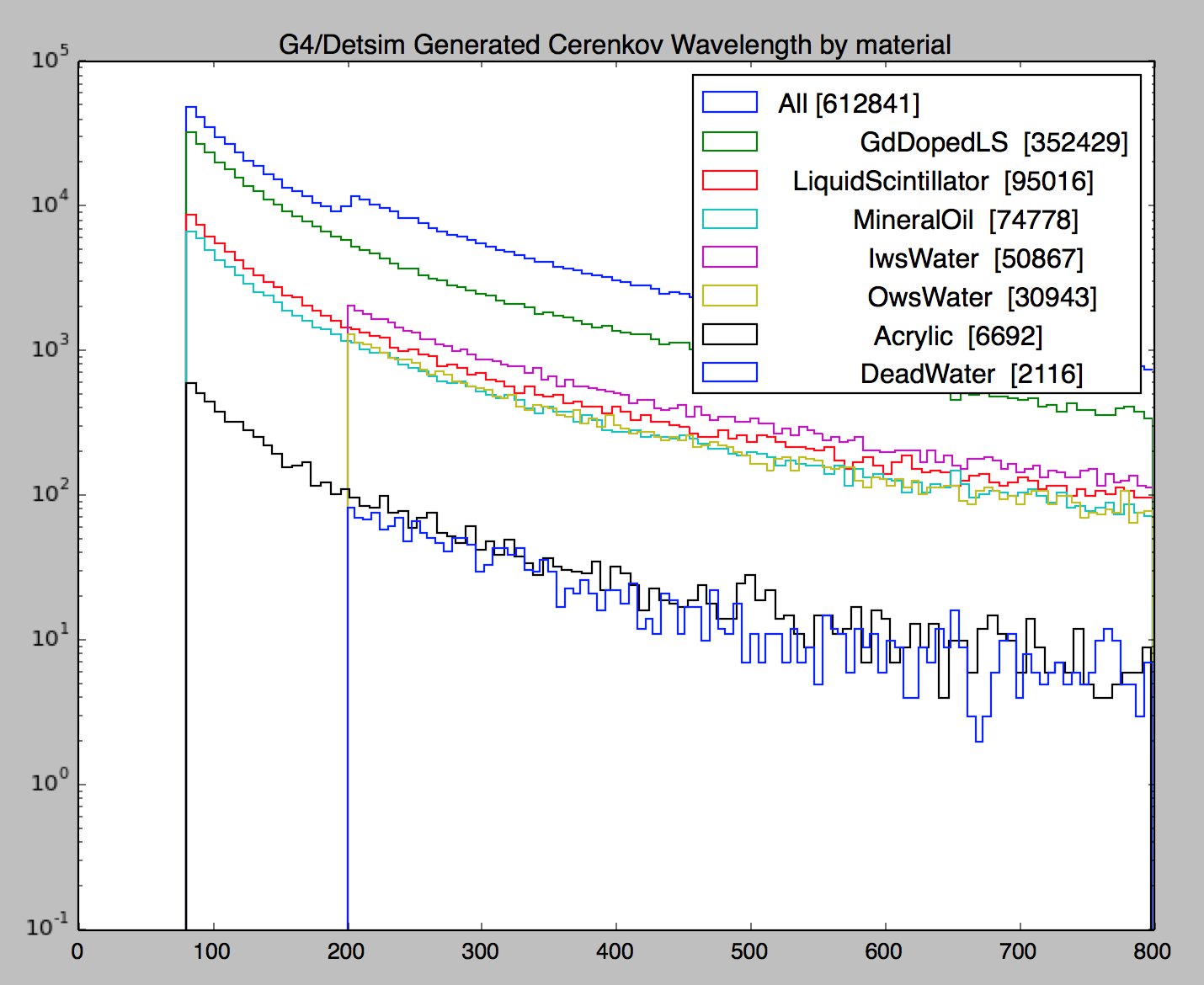
Refractive Index Interpolation Explains Jump at 200nm
DeadWater, IwsWater, OwsWater have same RINDEX starting from 200nm. Chroma interpolates properties onto a standard set of wavelengths, getting rid of the jump.
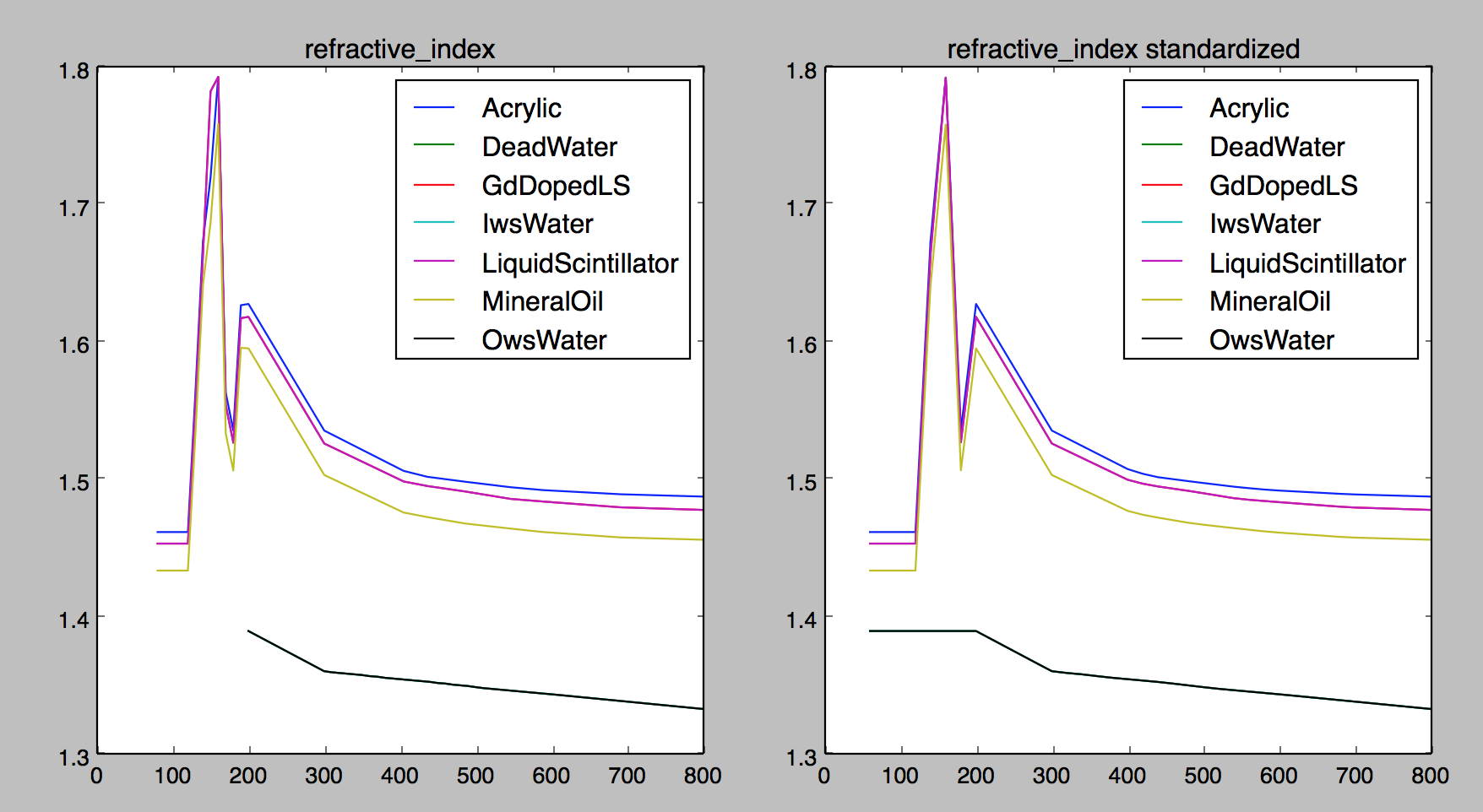
Comparison of Generated Scintillation Photon Distributions
Position, direction, polarization XYZ + time, wavelength, weight
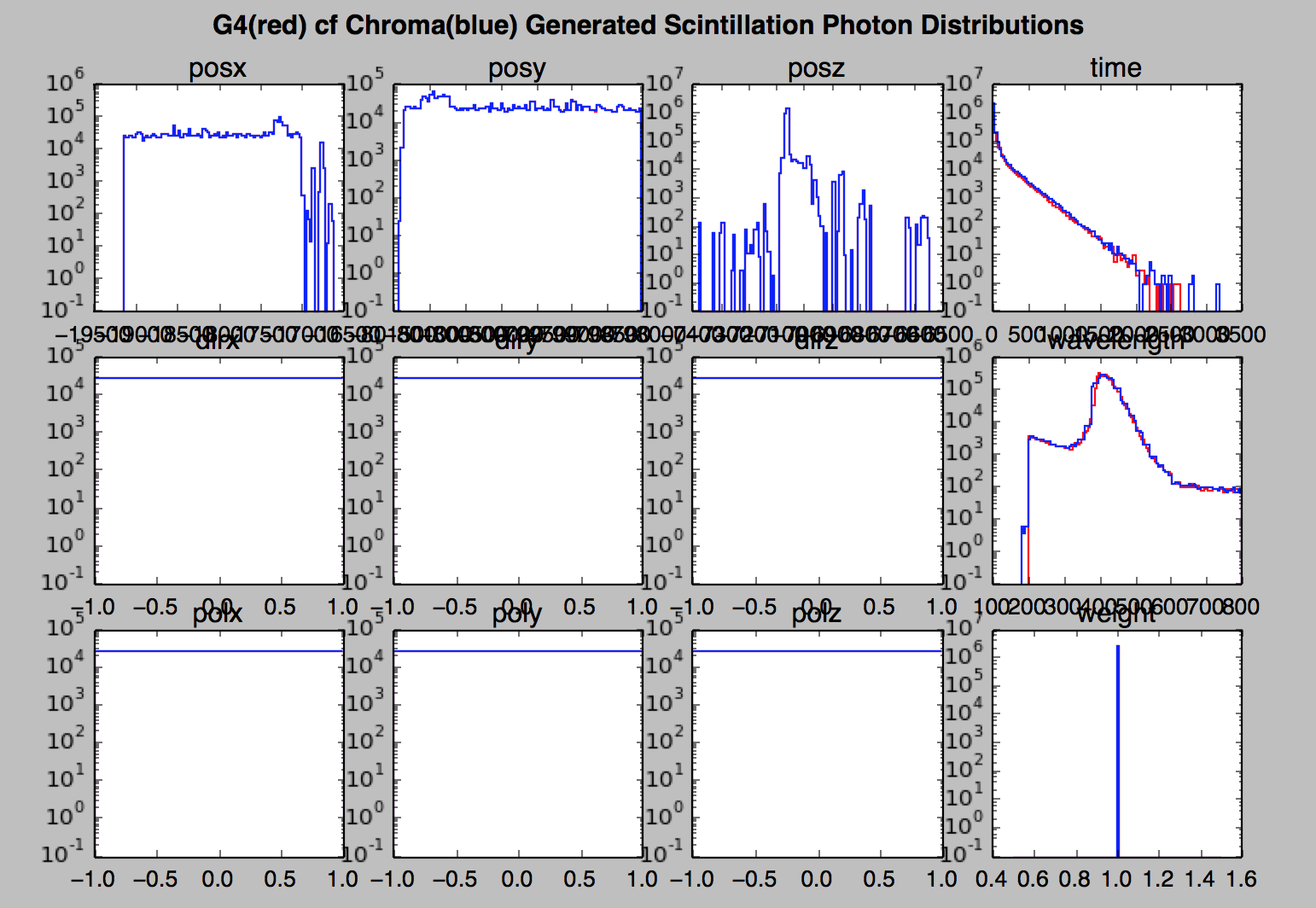
Comparison of Generated Cerenokov Photon Distributions
Position, direction, polarization XYZ + time, wavelength, weight
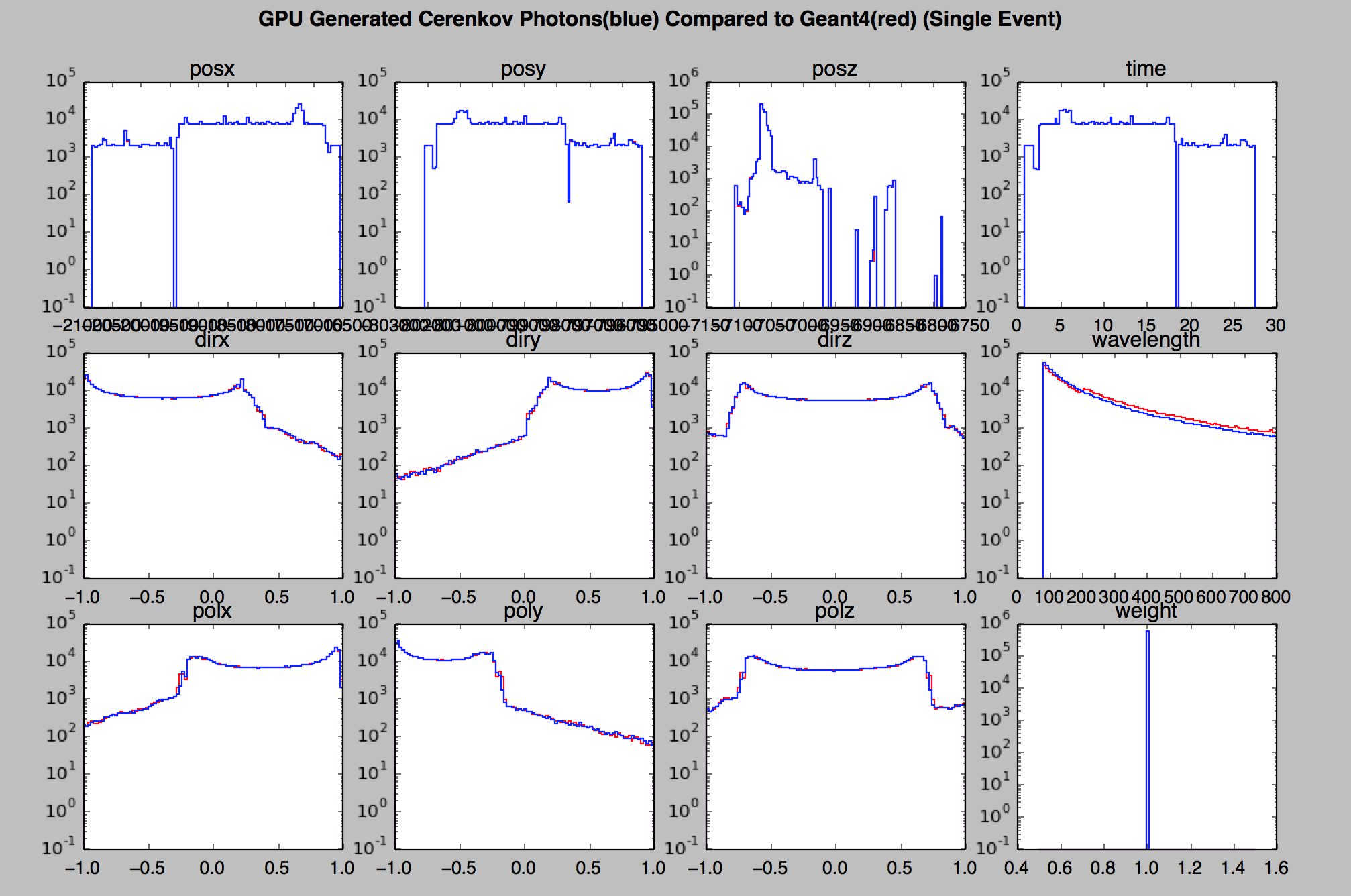
g4daeview.py : Dayabay Chroma Photon Propagation (1)
Chroma GPU photon propagation at 12 nanoseconds. The photons are generated by Geant4 simulation of a 100 GeV muon travelling from right to left. Photon colors indicate reemission (green), absorption(red), specular reflection (magenta), scattering(blue), no history (white).
